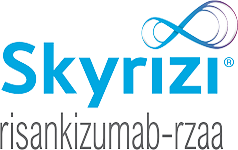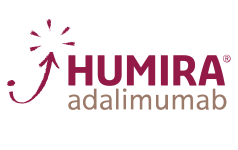For pediatric patients (5 years of age and older) with moderate to severe ulcerative colitis (UC)
Remission in pediatric patients with UC1
ENVISION
Patients aged 5 to 17 with moderate to severe UC who had an inadequate response or intolerance to conventional therapy. Approximately 16% had failed prior anti-TNF treatment.1
Study design intro: A multicenter, randomized, double-blind, 52-week trial in 93 pediatric patients from 5 to 17 years of age with moderate to severe ulcerative colitis who had an inadequate response or intolerance to conventional therapy. Co-primary endpoints: clinical remission per PMS (partial Mayo score) at Week 8, and clinical remission per FMS (full Mayo score) at Week 52 in patients who achieved clinical response per PMS at Week 8. Only the high induction dose is depicted. See Study Details and Additional Results for additional data.1
Remission per PMS at Week 81,*,✝
- HUMIRAa
aMax 160 mg at Week 0, Max 160 mg at Week 1, Max 80 mg at Week 2.
~84% of patients in the study were bio-naive1,‡
*Clinical remission defined as partial Mayo score (PMS) ≤2 and no individual subscore >1; no endoscopic component.1
†Intent-to-treat (ITT-E) population, non-responder imputation (NRI).
‡Bio-naïve refers to patients who were anti-TNF naïve.
Remission at Week 52 in Week 8 PMS responders1,*,✝,‡
- HUMIRAa
aMax 40 mg every week.
~84% of patients in the study were bio-naive1,¶
Study design intro: A multicenter, randomized, double-blind, 52-week trial in 93 pediatric patients from 5 to 17 years of age with moderate to severe ulcerative colitis who had an inadequate response or intolerance to conventional therapy. Co-primary endpoints: clinical remission per PMS (partial Mayo score) at Week 8, and clinical remission per FMS (full Mayo score) at Week 52 in patients who achieved clinical response per PMS at Week 8. Only the every week maintenance dose is depicted. See Study Details and Additional Results for additional data.1
At Week 8, patients who demonstrated clinical response per PMS were randomized equally to receive double-blind maintenance treatment at a dose of 0.6 mg/kg (maximum 40 mg) every week or every other week.1
*Clinical remission per full Mayo score defined as a Mayo score ≤2 and no individual subscore >1.1
†Clinical response per partial Mayo score (PMS) defined as a decrease in PMS ≥2 points and ≥30% from baseline.1
‡Modified intent-to-treat (m-ITT-E) population, non-responder imputation (NRI).
¶Bio-naïve refers to patients who were anti-TNF naïve.
Response at Week 52 in Week 8 PMS responders1,*,✝,‡
- HUMIRAa
aMax 40 mg every week.
~84% of patients in the study were bio-naive1,§
*Clinical response per full Mayo score defined as a decrease in Mayo score ≥3 points and ≥30% from baseline.1
†Clinical response per partial Mayo score (PMS) defined as a decrease in PMS ≥2 points and ≥30% from baseline.1
‡Modified intent-to-treat (m-ITT-E) population, non-responder imputation (NRI).
§Bio-naïve refers to patients who were anti-TNF naïve.
Endoscopic improvement at Week 52 in Week 8 responders1,*,✝,‡
- HUMIRAa
aMax 40 mg every week.
~84% of patients in the study were bio-naive1,§
Study design intro: A multicenter, randomized, double-blind, 52-week trial in 93 pediatric patients from 5 to 17 years of age with moderate to severe ulcerative colitis who had an inadequate response or intolerance to conventional therapy. Co-primary endpoints: clinical remission per PMS (partial Mayo score) at Week 8, and clinical remission per FMS (full Mayo score) at Week 52 in patients who achieved clinical response per PMS at Week 8. Only the every week maintenance dose is depicted. See Study Details and Additional Results for additional data.1
At Week 8, patients who demonstrated clinical response per PMS were randomized equally to receive double-blind maintenance treatment at a dose of 0.6 mg/kg (maximum 40 mg) every week or every other week.1
*Endoscopic improvement at Week 52 measured by Mayo endoscopic subscore (defined as ≤1).1
†Clinical response per partial Mayo score (PMS) defined as a decrease in partial Mayo score ≥2 points and ≥30% from baseline.1
‡Modified intent-to-treat (m-ITT-E) population, non-responder imputation (NRI).
§Bio-naïve refers to patients who were anti-TNF naïve.
Remission at Week 52 in Week 8 PMS remitters1,*,✝,‡
- HUMIRAa
aMax 40 mg every week.
~84% of patients in the study were bio-naive1,§
Study design intro: A multicenter, randomized, double-blind, 52-week trial in 93 pediatric patients from 5 to 17 years of age with moderate to severe ulcerative colitis who had an inadequate response or intolerance to conventional therapy. Co-primary endpoints: clinical remission per PMS (partial Mayo score) at Week 8, and clinical remission per FMS (full Mayo score) at Week 52 in patients who achieved clinical response per PMS at Week 8. Only the every week maintenance dose is depicted. See Study Details and Additional Results for additional data.1
At Week 8, patients who demonstrated clinical response per PMS were randomized equally to receive double-blind maintenance treatment at a dose of 0.6 mg/kg (maximum 40 mg) every week or every other week.1
*Clinical remission per full Mayo score defined as a Mayo score ≤2 and no individual subscore >1.1
†Clinical remission per partial Mayo score (PMS) defined as a partial Mayo score ≤2 and no individual subscore >1; no endoscopic component.1
‡Modified intent-to-treat (m-ITT-E) population, non-responder imputation (NRI).
§Bio-naïve refers to patients who were anti-TNF naïve.
Response: Weeks 2, 4, and 8 per PMS3,*,†
- HUMIRA
Exploratory Analysis
Max 160 mg at Week 0; Max 160 mg at Week 1; Max 80 mg at Week 2
~84% of patients in the study were bio-naive1,‡
DATA LIMITATIONS
Exploratory analyses were not powered or tested to demonstrate a statistically significant difference in treatment effect; no statistical inferences can be made due to the exploratory nature of the analysis.
*Clinical response per partial Mayo score defined as a decrease in partial Mayo score ≥2 points and ≥30% from baseline.1
†Modified intent-to-treat (m-ITT-E) population, non-responder imputation (NRI).
‡Bio-naïve refers to patients who were anti-TNF naïve.
PMS=partial Mayo score
Remission: Weeks 2, 4, and 8 per PMS3,*,†
- HUMIRA
Exploratory Analysis
Max 160 mg at Week 0; Max 160 mg at Week 1; Max 80 mg at Week 2
~84% of patients in the study were bio-naive1,‡
DATA LIMITATIONS
Exploratory analyses were not powered or tested to demonstrate a statistically significant difference in treatment effect; no statistical inferences can be made due to the exploratory nature of the analysis.
*Clinical remission defined as partial Mayo score ≤2 and no individual subscore >1; no endoscopic component.1,2
†Modified intent-to-treat (m-ITT-E) population, non-responder imputation (NRI).
‡Bio-naïve refers to patients who were anti-TNF naïve.
PMS=partial Mayo score
Response: Weeks 2, 4, and 8 per PUCAI3,*,†
- HUMIRA
Exploratory Analysis
Max 160 mg at Week 0; Max 160 mg at Week 1; Max 80 mg at Week 2
~84% of patients in the study were bio-naive1,‡
DATA LIMITATIONS
Exploratory analyses were not powered or tested to demonstrate a statistically significant difference in treatment effect; no statistical inferences can be made due to the exploratory nature of the analysis.
Study design intro: A multicenter, randomized, double-blind, 52-week trial in 93 pediatric patients from 5 to 17 years of age with moderate to severe ulcerative colitis who had an inadequate response or intolerance to conventional therapy. Co-primary endpoints: clinical remission per PMS (partial Mayo score) at Week 8, and clinical remission per FMS (full Mayo score) at Week 52 in patients who achieved clinical response per PMS at Week 8. See Study Details and Additional Results for additional data.1
*Clinical response per the Pediatric Ulcerative Colitis Activity Index (PUCAI) defined as a decrease in PUCAI ≥20 points from baseline.2
†Modified intent-to-treat (m-ITT-E) population, non-responder imputation (NRI).
‡Bio-naive refers to patients who were anti-TNF naïve.
Remission: Weeks 2, 4, and 8 per PUCAI3,*,†
- HUMIRA
Exploratory Analysis
Max 160 mg at Week 0; Max 160 mg at Week 1; Max 80 mg at Week 2
~84% of patients in the study were bio-naive1,‡
DATA LIMITATIONS
Exploratory analyses were not powered or tested to demonstrate a statistically significant difference in treatment effect; no statistical inferences can be made due to the exploratory nature of the analysis.
Study design intro: A multicenter, randomized, double-blind, 52-week trial in 93 pediatric patients from 5 to 17 years of age with moderate to severe ulcerative colitis who had an inadequate response or intolerance to conventional therapy. Co-primary endpoints: clinical remission per PMS (partial Mayo score) at Week 8, and clinical remission per FMS (full Mayo score) at Week 52 in patients who achieved clinical response per PMS at Week 8. See Study Details and Additional Results for additional data.1
*Clinical remission per the Pediatric Ulcerative Colitis Activity Index (PUCAI) remission is defined as PUCAI < 10.2
†Modified intent-to-treat (m-ITT-E) population, non-responder imputation (NRI).
‡Bio-naive refers to patients who were anti-TNF naïve.
Safety data: treatment-emergent adverse events* (AE) in pediatric UC2
Similar safety profile in pediatric and adult patients with moderate to severe UC2
| AE category | Maintenance Period |
| AE | 66.7% (n=42/63) |
| Serious AE | 14.3% (n=9/63) |
| Severe AE | 6.3% (n=4/63) |
| AE leading to discontinuation of study drug | 3.2% (n=2/63) |
| AEs possibly related to study druga | 28.6% (n=18/63) |
| Serious AEs possibly related to study druga | 1.6% (n=1/63) |
| Infections | 36.5% (n=23/63) |
| Serious infections | 7.9% (n=5/63) |
| Latent tuberculosis | 1.6% (n=1/63) |
| Active tuberculosis | 0 |
| Malignancies | 0 |
| Lymphoma | 0 |
| Allergic reactionb | 4.8% (n=3/63) |
| Worsening or new onset of psoriasis | 0 |
| Pancreatitis | 0 |
| Hematologic disorders including pancytopenia | 6.3% (n=4/63) |
| Injection site reaction | 9.5% (n=6/63) |
aReasonable possibility of being related, as assessed by investigator.
bCategory including angioedema/anaphylaxis.
| HUMIRA + MTX (n=268) PYs=482 |
HUMIRA monotherapy >(n=274) PYs=435 |
MTX monotherapy (n=257) PYs=429 |
|
| SERIOUS INFECTION | 2.9 | 0.7 | 1.6 |
| MALIGNANCY* | 0.4 | 0.9 | 0.7 |
| ACTIVE TUBERCULOSIS | 0 | 0 | 0 |
| LYMPHOMA | 0 | 0 | 0.2 |
No new safety signals identified in 63 patients1
*Treatment-emergent AEs are defined as events with an onset date on or after the first dose date of the study drug in the maintenance period and prior to re-randomization due to first disease flare if applicable and up to 70 days after the last dose date of the study drug in the maintenance period.
PI=prescribing information




